Welcome to Visit Leeds Places
The Walkfo guide to things to do & explore in Leeds
![]() Visit Leeds places using Walkfo for free guided tours of the best Leeds places to visit. A unique way to experience Leeds’s places, Walkfo allows you to explore Leeds as you would a museum or art gallery with audio guides.
Visit Leeds places using Walkfo for free guided tours of the best Leeds places to visit. A unique way to experience Leeds’s places, Walkfo allows you to explore Leeds as you would a museum or art gallery with audio guides.
Visiting Leeds Walkfo Preview
Leeds is to the east of Bradford, north of Sheffield, south-west of York, and north-east of Manchester . The city forms the core of the City of Leeds metropolitan borough, which also includes the towns of Horsforth, Morley, Otley, Pudsey, Rothwell and Wetherby . Leeds is the largest subdivision of the West Yorkshire Built-up Area (2011 census classification) and the Yorkshire and Humber region’s most populous . When you visit Leeds, Walkfo brings Leeds places to life as you travel by foot, bike, bus or car with a mobile phone & headphones.
Leeds Places Overview: History, Culture & Facts about Leeds
Visit Leeds – Walkfo’s stats for the places to visit
With 238 audio plaques & Leeds places for you to explore in the Leeds area, Walkfo is the world’s largest heritage & history digital plaque provider. The AI continually learns & refines facts about the best Leeds places to visit from travel & tourism authorities (like Wikipedia), converting history into an interactive audio experience.
Leeds history
Toponymy
The name derives from the old Brythonic word Ladenses meaning “people of the fast-flowing river”, in reference to the River Aire that flows through the city . An inhabitant of Leeds is locally known as a Loiner, a word of uncertain origin . The term Leodensian is also used, from the city’s Latin name .
Economic development
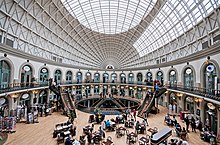
Leeds developed as a market town in the Middle Ages as part of the local agricultural economy . Before the Industrial Revolution, it became a co-ordination centre for the manufacture of woollen cloth . Leeds handled one sixth of England’s export trade in 1770 . Mechanical engineering, initially to supply tools and machinery, rapidly became a diverse industry .
Suburban growth
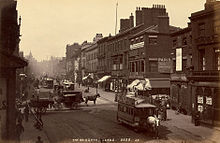
In 1801, 42% of the population of Leeds lived outside the township, in the wider borough . Residential growth occurred in Holbeck and Hunslet from 1801 to 1851, but as these townships became industrialised new areas were favoured for middle class housing . The wealthier residents left the industrial conurbation to live in Headingley, Potternewton and Chapel Allerton .
Leeds culture & places
In 2018, Leeds embarked on a five-year cultural investment programme, culminating in a year of cultural celebration in 2023. In 2023 the city will hold an international cultural festival which will harness the energy, creativity and momentum of the bid to be European Capital of Culture 2023, from which Leeds and other UK cities were disqualified following the United Kingdom’s vote to leave the EU.
Art
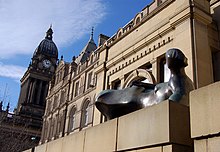
Although the city’s municipal art gallery (Leeds Art Gallery) did not open until 1888, art practice and collecting has a long history in Leeds. J. M. W. Turner painted numerous scenes in and around the city, and the city was home to one of Britain’s largest collections of Pre-Raphaelite Art, owned by Thomas Plint, during the nineteenth century. There was also an early history of holding large-scale public exhibitions in the city, most notably the series of ‘Polytechnic Exhibitions’ held regularly from 1839. Leeds produced many notable artists and sculptors, including Kenneth Armitage, John Atkinson Grimshaw, Jacob Kramer, Barbara Hepworth, Henry Moore, Edward Wadsworth and Joash Woodrow, and was the centre for a particularly radical strain of British art. Before the First World War Leeds was the home of an unusual modernist arts organisation, called the Leeds Arts Club, founded by Alfred Orage, which lasted from 1903 to 1923. Notable members included Jacob Kramer, Herbert Read, Frank Rutter and Michael Sadler. As well as advocating a radical political agenda, supporting the Suffragettes, the Independent Labour Party and the Fabian Society, and promoting the philosophy of Friedrich Nietzsche, the Leeds Arts Club was almost unique in Britain as being an exponent of German Expressionist ideas about art and culture. As a result, it staged very early British exhibitions of work by European expressionist artists, such as Wassily Kandinsky, showing their work in the city as early as 1913, and produced its own English Expressionist artists, including Jacob Kramer and Bruce Turner. In the 1920s Leeds College of Art was the starting point for the careers of the sculptors Barbara Hepworth and Henry Moore, and in the 1950s, and 1960s it was one of the leading centres for radical art education in Britain under the guidance of artists such as Harry Thubron and Tom Hudson, and the art historian Norbert Lynton. Their attempts to redefine what art education should mean in the post-Second World War period led the artist Patrick Heron to claim in 1971 in The Guardian newspaper that “Leeds is the most influential art school in Europe since the Bauhaus”. This willingness to push at the boundaries of acceptable public behaviour from artists was also evident in 1966 when Leeds College of Art staged an exhibition of paintings by the Cypriot artist Stass Paraskos, who taught at the college, which was raided by the police after allegations of obscenity. This radicalism continued into the 1970s when the higher education component of Leeds College of Art was split from the college to form the nucleus of the new multidisciplinary Leeds Polytechnic, now called Leeds Beckett University. Performance art had been taught earlier at Leeds College of Art, notably by the Fluxus artist Robin Page during his time as a tutor there in the mid-1960s, but in 1977 a performance art work hit the national news headlines when the students Pete Parkin and Derek Wain used an air pistol to shoot a line up of live budgerigars in front of an audience at Leeds Polytechnic. The University of Leeds was the alma mater of Herbert Read, one of the leading international theorists of modern art from the mid-twentieth century, and also the teaching base for the Marxist art historian Arnold Hauser from 1951 to 1985. Partly due to Herbert Read’s connection with the University, from 1950 to 1970 the University was the host of one of the first artist-in-residence schemes in Britain, using funding from the then owner of Lund Humphries books, Peter Gregory. The Gregory Fellowships, as the residencies were known, were given to painters and sculptors for up to two years to allow them to develop their own work and influence the University in any way they saw fit. Amongst those holding the fellowships were Kenneth Armitage, Reg Butler, Dennis Creffield and Terry Frost and others. Parallel Gregory Fellowships also existed in music and poetry at the University. Leeds was also a centre for radical feminist art, with one of the first galleries in Britain dedicated to showing the work of women photographers, the Pavilion Gallery, opening in the city in 1983, and the University of Leeds School of Fine Art being a well-known centre for the development of feminist art history, under Griselda Pollock, during the 1980s and 1990s. Possibly as a result of the strength of feminist art in Leeds, in November 1984 an exhibition of ceramics by students and staff at Leeds Polytechnic was attacked by a group of feminist activists who destroyed eight sculptures on display which they deemed to be degrading to women. The University of Leeds’s School of Fine Art also specialised in Art & Language conceptual art practice, under Terry Atkinson, again in the 1980s and 1990s. A major sculpture research centre and gallery, the Henry Moore Institute, is located alongside Leeds Art Gallery in the city centre, and in 2013 a new contemporary art centre, called The Tetley, opened on the site of the former Tetley Brewery to the south of the city centre. In March 2017, The Times voted Leeds as the number one cultural place to live in Britain. This was ahead of London, Birmingham, St Ives, Stratford-upon-Avon and Cheltenham. The citation notes that Leeds has Opera North, the Northern Ballet, and the Leeds Playhouse amongst many other attractions that ranked it at number one.
Carnivals and festivals
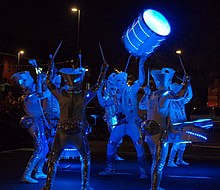
The Leeds Festival, featuring some of the biggest names in rock and indie music, takes place every year in Bramham Park . Light Night Leeds is one of the UK’s largest annual arts and light festivals . Garforth is host to the fortnight-long festival The Garforth Arts Festival which has been an annual event since 2005 .
Cinema
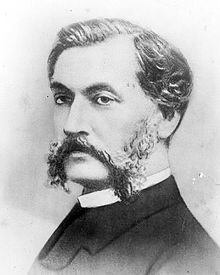
Leeds International Film Festival’s International Short Film Competition is named after Louis Le Prince . In 1888, Le Prince filmed moving picture sequences using his single-lens camera and Eastman’s paper film . Wordsworth Donisthorpe who was also from Leeds, filmed the second-oldest-surviving film . Leeds has a rich film exhibition culture with numerous cinemas and pop-up venues .
Literature
There are plans to create a National Poetry Centre in Leeds . Leeds has produced many writers of note, including celebrated author and playwright Alan Bennett . The British Library houses a significant portion of its collection just outside Boston Spa .
Museums

Leeds has over 16 museums and galleries including 9 that are council-run . A new Leeds City Museum opened in 2008 in Millennium Square . Armley Mills Industrial Museum is housed in what was once the world’s largest woollen mill .
Music, theatre and dance
The City Varieties Music Hall is one of the UK’s few remaining music halls . It was also the venue of the BBC television programme The Good Old Days . The First Direct Arena opened in September 2013 and is rapidly becoming the city’s number one venue for live music and indoor sports .
Nightlife
Leeds is Purple Flag accredited to indicate an entertaining, diverse, safe and enjoyable night . Popular areas for nightlife in Leeds include Call Lane, Briggate and the Arena Quarter . Millennium Square is a growing entertainment district providing for both students and weekend visitors .
Leeds economy & business
Finance
Leeds is the UK’s third-largest manufacturing centre with around 1,800 firms and 39,000 employees . Finance and business services account for 38% of total output . Over 30 national and international banks, many of whose northern or regional offices are based in the city .
Law
There are around 150 law firms operating in Leeds, employing over 6,700 people . Specialist legal expertise to be found in Leeds includes corporate finance, corporate restructuring and insolvency . The establishment of an Administrative Court in Leeds reinforced Leeds’s position as one of the UK’s key legal centres .
Manufacturing
50% of the UK’s manufacturing base is within a two-hour drive of Leeds . Manufacturing and distribution accounted for £26m of new property development in the period .
Graphics and gaming
In 2009 Leeds was the first city outside London to host the Eurogamer Expo . There is an established creative industry in the city, particularly in the digital gaming sector .
Leisure and tourism

Tourism is important to the Leeds economy, in 2009 Leeds was the eighth-most visited city in England by UK visitors . Research by VisitEngland reported that the day visitor market to Leeds attracts 24.9 million people each year, worth over £654 million to the local economy .
Public sector

108,000 people work in the public sector in Leeds, 24% of the workforce . The largest employers are Leeds City Council, with 33,000 staff, and the Leeds Teaching Hospitals NHS Trust, with 14,000 . Leeds has become a hub of public-sector health bodies .
Shopping

The extensive retail area of Leeds is identified as the principal regional shopping centre for the whole of the Yorkshire and the Humber region . In total there are well over 1,000 retail stores, with a combined floorspace of 3,660,000 square feet (340,000 m) in Leeds City Centre . Briggate is the main shopping street where one can find many well-known British High Street stores, including Marks & Spencer, House of Fraser, Debenhams, Topshop, Costa Coffee and Harvey Nichols .
Leeds landmarks
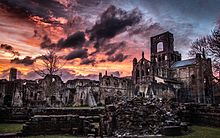
Natural landmarks include gritstone outcrop of Otley Chevin and the Fairburn Ings RSPB reserve. The built environment embraces edifices of civic pride like Morley Town Hall and the trio of buildings in Leeds, Leeds Town Hall, Corn Exchange and Leeds City Museum by the architect Cuthbert Brodrick. The 112-metre (367 ft) tower of Bridgewater Place, also known as The Dalek, is the region’s tallest building.
Leeds geography / climate

Leeds is located 169 miles (272 km) north-northwest of London, on the valley of the River Aire in the eastern foothills of the Pennines. The city centre lies in a narrow section of the Aire Valley at about 206 feet (63 m) above sea level. The centre of Leeds is part of a continuously built-up area extending to Pudsey, Bramley, Horsforth, Alwoodley, Seacroft, Middleton and Morley. Leeds has the second-highest population of any local authority district in the UK (after Birmingham)
Watercourses
In addition to the rivers Aire and Wharfe, other watercourses (generally known as becks) include: Adel Beck, which flows southwards from Adel Dam and through Adel Woods to join Meanwood Beck just south of the Leeds Outer Ring Road . Collingham Beck may have been diverted during the medieval period to power a mill or support a moat .
Climate
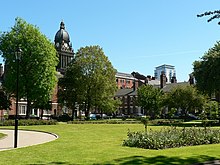
Leeds has a climate that is oceanic (Köppen: Cfb), and influenced by the Pennines . Summers are usually mild, with moderate rainfall, while winters are chilly, cloudy with occasional snow and frost . July is the warmest month, with a mean temperature of 16 °C (61 °F), while the coldest month is January . Temperatures above 30 °C are not very common but can happen occasionally .
Why visit Leeds with Walkfo Travel Guide App?
![]() You can visit Leeds places with Walkfo Leeds to hear history at Leeds’s places whilst walking around using the free digital tour app. Walkfo Leeds has 238 places to visit in our interactive Leeds map, with amazing history, culture & travel facts you can explore the same way you would at a museum or art gallery with information audio headset. With Walkfo, you can travel by foot, bike or bus throughout Leeds, being in the moment, without digital distraction or limits to a specific walking route. Our historic audio walks, National Trust interactive audio experiences, digital tour guides for English Heritage locations are available at Leeds places, with a AI tour guide to help you get the best from a visit to Leeds & the surrounding areas.
You can visit Leeds places with Walkfo Leeds to hear history at Leeds’s places whilst walking around using the free digital tour app. Walkfo Leeds has 238 places to visit in our interactive Leeds map, with amazing history, culture & travel facts you can explore the same way you would at a museum or art gallery with information audio headset. With Walkfo, you can travel by foot, bike or bus throughout Leeds, being in the moment, without digital distraction or limits to a specific walking route. Our historic audio walks, National Trust interactive audio experiences, digital tour guides for English Heritage locations are available at Leeds places, with a AI tour guide to help you get the best from a visit to Leeds & the surrounding areas.
“Curated content for millions of locations across the UK, with 238 audio facts unique to Leeds places in an interactive Leeds map you can explore.”
Walkfo: Visit Leeds Places Map
238 tourist, history, culture & geography spots
Leeds historic spots | Leeds tourist destinations | Leeds plaques | Leeds geographic features |
| Walkfo Leeds tourism map key: places to see & visit like National Trust sites, Blue Plaques, English Heritage locations & top tourist destinations in Leeds | |||
Best Leeds places to visit
Leeds has places to explore by foot, bike or bus. Below are a selection of the varied Leeds’s destinations you can visit with additional content available at the Walkfo Leeds’s information audio spots:

Cross Green, Leeds
Cross Green is 1 mile (1.6 km) on a hill to the south east of Leeds city centre . The area lies in the LS9 Leeds postcode area between Osmondthorpe, Richmond Hill and Hunslet .

Hunslet Mill
Hunslet Mill and Victoria Works Complex is a series of very large disused mill buildings in Goodman Street in Leeds . The Hunslet mill and Victoria works complex is located in the centre of Goodman Street .

Sheepscar
Sheepscar is an inner city district of Leeds in West Yorkshire . The district is in the City of Leeds Metropolitan Council . It is overlooked by the tower blocks of Little London and Lovell Park to the west .

Greenhouse (Leeds)
Greenhouse is an eight-storey, mixed-use block of eco-flats in Beeston, Leeds. The building took its present form in 2010 after renovation of a 1938 development, Shaftesbury House.

City Evangelical Church, Leeds
City Evangelical Church is an independent evangelical church in Beeston, Leeds, England. It is situated on Cemetery Road in the former Beeston Hill Baptist Chapel. The church is affiliated to the Fellowship of Independent Evangelical Churches.

Holbeck Working Men’s Club
The Holbeck (formerly the Holbeck Working Men’s Club or Holbeck WMC) in Leeds is one of the United Kingdom’s oldest working men’s clubs. It is thought to be the UK’s oldest surviving working men’s club.

Midland Mills, Leeds
Midland Mills is a former flax mill on Silver Street in Holbeck, Leeds, West Yorkshire, in the Holbeck Urban Village regeneration area. Since the 1980s it has been used for light industrial work.

Holbeck Urban Village
Holbeck Urban Village is an area of Leeds city centre close to Leeds railway station. The area has been undergoing a period of urban renewal.
Granary Buildings, Leeds
Granary Buildings is a heritage listed building in Leeds, West Yorkshire, England. It was built in the 1930s and is now a Grade II listed building. It is located in the city centre of Leeds.

Granary Wharf
Granary Wharf is a mixed-use development that stands next to the brick tunnels beside the Leeds and Liverpool Canal and the River Aire. Leeds City railway station sits above the tunnel complex on Dark Neville Street. The tunnel complex is known locally as the Dark Arches.
Visit Leeds plaques
![]() 122
122
plaques
here Leeds has 122 physical plaques in tourist plaque schemes for you to explore via Walkfo Leeds plaques audio map when visiting. Plaques like National Heritage’s “Blue Plaques” provide visual geo-markers to highlight points-of-interest at the places where they happened – and Walkfo’s AI has researched additional, deeper content when you visit Leeds using the app. Experience the history of a location when Walkfo local tourist guide app triggers audio close to each Leeds plaque. Explore Plaques & History has a complete list of Hartlepool’s plaques & Hartlepool history plaque map.


